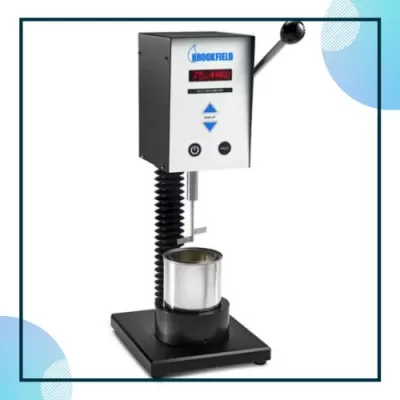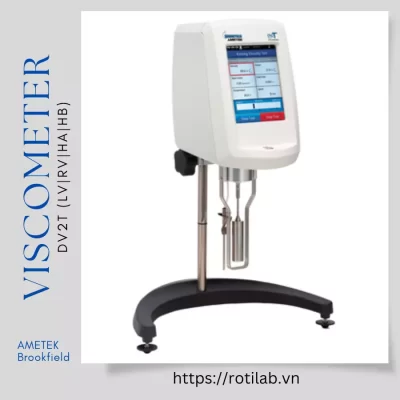
Độ nhớt là gì?
- Kết quả thường được biểu thị bằng centipoise (cP), tương đương với 1 mPa s (millipascal giây).
- Ứng suất cắt là lực trên một đơn vị diện tích cần thiết để di chuyển một lớp chất lỏng so với lớp khác.
- Tốc độ cắt là thước đo sự thay đổi tốc độ mà các lớp trung gian di chuyển đối với nhau.
Contents
Tại sao kiểm tra độ nhớt là cần thiết?

Làm thế nào để kiểm tra/đo độ nhớt?
Độ nhớt động học
Độ nhớt động lực
Sử dụng nhớt kế để kiểm tra độ nhớt
 Máy đo độ nhớt AMETEK Brookfield đã được chứng minh là tiêu chuẩn thế giới khi đo độ nhớt. Với nhu cầu kiểm soát chất lượng tốt hơn và khả năng xử lý được cải thiện liên tục theo yêu cầu, chúng tôi đã bổ sung và cải thiện phạm vi nhớt kế hiệu suất cao của mình.
Máy đo độ nhớt AMETEK Brookfield đã được chứng minh là tiêu chuẩn thế giới khi đo độ nhớt. Với nhu cầu kiểm soát chất lượng tốt hơn và khả năng xử lý được cải thiện liên tục theo yêu cầu, chúng tôi đã bổ sung và cải thiện phạm vi nhớt kế hiệu suất cao của mình.English below
Have you ever wondered why it takes more force to stir honey or oil than water or even milk? Why do some materials flow with greater ease than others? Or better still, why is this attribute even important in the world of testing and quality control?
Clearly, the attribute that we are talking about here is nothing but, Viscosity. Well, let’s begin by understanding what viscosity is and how it influences the quality of a product.
Simply put, a fluid’s internal resistance to flow is called viscosity. When there is relative motion between layers of fluid, viscosity can be defined and measured.
Viscosity is the measure of a substance’s resistance to motion under an applied force – as per the definition.
Viscosity = shear stress/shear rate
The result is typically expressed in centipoise (cP), which is the equivalent of 1 mPa s (millipascal second).
Shear stress is the force per unit area required to move one layer of fluid in relation to another.
Shear rate is the measure of the change in speed at which intermediate layers move with respect to one another.
In simple terms, viscosity can be referred to as the thickness of a fluid. Why does water flow faster than honey or oil? It is basically because of the difference in viscosities. Water has low viscosity, whereas honey and oil both have higher viscosities.
Fluids may respond differently to changes in shear rate. This is where the Newtonian and Non Newtonian concept comes in. At a given temperature and shear stress, the viscosity of a Newtonian fluid would remain constant regardless of changes to the shear rate. However, this is only true for some fluids.
While water and honey, which are Newtonian fluids, behave this way, most fluids fluctuate depending on the shear rate -these other fluids are called non-Newtonian fluids. Examples of such fluids are toothpaste, cosmetic creams, jam, mayonnaise, etc.
At a molecular level, the interaction between molecules in a fluid causes viscosity. In other words, it can also be referred to as friction between the molecules in the fluid. Like friction in moving solids, viscosity determines the energy required to make a fluid flow.
Why is viscosity testing necessary?
Viscosity is a widely measured property and is critical, especially when it comes to quality testing in a wide range of industries. It is essential to ensure products have the look and feel that customers are expecting For example, if toothpaste is very runny, it would be challenging to use. Conversely, if it is too thick, it would be hard to dispense it from the tube! Viscosity measurements can be used to help maintain quality and consistency in your products.
At AMETEK Brookfield, we follow this simple rule:
Careful Measurement = Consistent Product
When the correct testing and measurement methods are used, the result will surely be a consistent and good quality product.
Let us see examples of how Viscosity applications find their way in some industries.
However, these are not the only ones.
Food Industry: When it comes to production efficiency, cost-effectiveness, or quality, viscosity measurements play a crucial role. The viscosity of a product for instance, mayonnaise sauce or a ketchup, will determine the rate at which it flows through a pipe, how long it takes to set or dry, or even how easily it can be dispensed into packaging. In fact, the viscosity of the food item has to be aligned with the production process to ensure optimized product flow and proper packaging.
Adhesives: To get the suitable viscosity of an adhesive, consider the required flow of the product. For instance, a low viscosity adhesive will flow faster than the high viscosity one. Therefore, if you want your adhesive to flow easily and spread out, or if you want the adhesive to be thicker and to stay where it’s applied, the viscosity must be properly controlled.
AMETEK Brookfield’s Gel Timer Instruments, namely, the DVNext Rheometer with Gel Timer Functionality and Gel Timer DV2T Instrument are specially designed to measure the curing time of adhesives, polymers etc.
Paints and coatings: The Viscosity of a paint is nothing but its thickness which plays an important role in determining how easily it can be applied using either a brush, a sprayer, or a roller. In other words, if a highly viscous paint is applied using a sprayer, the result may not be something desirable, or it might even resist the application.
KU-3 Viscometer and FAST Viscometer from AMETEK Brookfield have rugged designs and are used widely for Viscosity measurements on paints, inks and coatings. Visit store to learn more
Lubricants and petroleum products: Viscosity measurements not only project the effectiveness of lubricating oil and petroleum products but also determine pipeline design elements.
AMETEK Brookfield’s DV range of Viscometers come with advanced features and are popular Viscosity measurement instruments for quality check of lubricants and petroleum products.
In a nutshell, gathering viscosity data on a material gives manufacturers the edge in predicting how the material will behave in the real world. Also, knowing the viscosity of a material affects the production and transportation processes.

How to test/measure viscosity?
Viscosity can be measured using different methods depending on the materials that have to be tested.
In order to understand this better, it would be helpful to know the types of viscosity.
Kinematic Viscosity
Kinematic Viscosity is the ratio of dynamic viscosity to the density of the liquid. It is a measure of a fluid’s resistance to shear flow under the weight of gravity, or in other words, it is a measure of a fluid’s resistance to flow when no external forces except gravity are acting.
It is primarily used in describing Newtonian fluids. Centistokes (cSt) is the most common kinematic viscosity measurement unit. Centisokes equals 1 millimeter squared per second (mm²/s).
Dynamic Viscosity
Dynamic Viscosity is the measure of a fluid’s resistance to shear flow when an external force is applied. It is helpful in describing the behavior of fluids under stress. This is mainly used in describing non-Newtonian fluids by observing how viscosity changes as the shear velocity changes.
Using viscometers to test viscosity
There are many types of viscometers, as there are methods available to measure the viscosity of materials. Long ago, when the need for testing viscosity was realized, the earliest methods used were capillary tubes. Slowly and gradually, times changed, and with the development of technologies, different techniques and advanced instruments were added.
Viscosity measurements are often distinguished as either kinematic or dynamic viscosity. While relative viscosity will give a general value, instruments that can measure dynamic viscosity or absolute viscosity have been refined with time and proven to provide more reliable and accurate measurements. This is because absolute Viscosity is given instead of values that compare fluids to one another.
AMETEK Brookfield Viscometers are proven world standards when it comes to viscosity measurements. With the need for better quality control and improved processing capabilities constantly on demand, we have been adding and improving our range of high-performing viscometers. Designed with the latest innovation and best-in-class technology, they are proven to provide accurate dynamic or absolute viscosity measurements, depending on your requirements.
Viscosity might seem complex, but the right instrument will help you easily test this characteristic. If you wish to get more information on how our Viscometers can add value to your business or which instrument is best suited for your need, get in touch with us.


